氮化物荧光粉
稀土掺杂日用玻璃
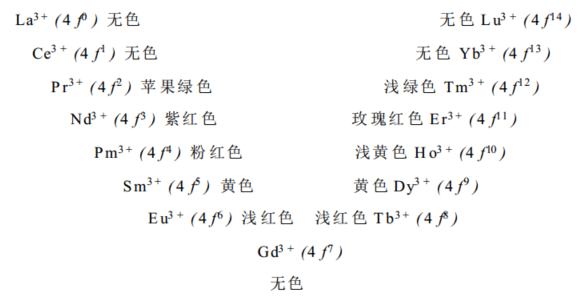
参考《稀土元素-您身边的大家庭》
蓝光LED厂商有Citizen(西铁城,日本), CREE(科锐,美国), Epistar(晶元光电,中国台湾), GE, GLI, Nichia, Osram Opto(欧司朗,德国), Panasonic, Philips Lumileds, Samsung, Seoul Semiconductors(首尔半导体), Soraa(中村修二创办的), Toyoda Gosei(丰田合成), and so on.
GE updates on its phosphor technologies
参考资料:
(1) 稀土发光材料亟需技术和应用双驱协同创新-发光学报-2020
(2) 质量监控一手掌握:欧司朗推出适合光谱应用的全球最小宽波段红外LED
(3) 《光:科学与应用》:向压敏荧光粉添加记忆功能
荧光粉中激活剂离子掺杂格位分析
参考资料:
(1) 荧光粉中激活剂离子掺杂格位分析-发光学报-姬海鹏
(2) Luminescence of Ce3+ at two different sites in α-Sr2P2O7 under vacuum ultraviolet-UV and x-ray excitation
Luminescent Materials for Laser-Driven Solid-State Lighting
在高功率密度下,LED存在难以解决的“效率下降”难题。与LED相比,LD不仅效率更高、亮度更强、照射距离更远,而且克服了LED固有的高功率下“效率下降”问题。
Unraveling the Luminescence Quenching of Phosphors under High-Power-Density Excitation
Reliability of Blue-Emitting Eu2+-Doped Phosphors for Laser-Lighting Applications (也存在变价)
LD照明用荧光材料
- 荧光玻璃,制造工艺简单和光学性能优异等优点,但由于玻璃的热导率较低,同时制备过程中玻璃基质容易与荧光材料发生反应破坏荧光材料的发光性能;
- 荧光薄膜,与荧光玻璃相比,荧光薄膜的热导率得到一定的提升,但是由于薄膜和基体之间结合界面存在一定的缺陷且结构无法调控等原因影响其在激光照明中的应用;
- 荧光单晶,与荧光薄膜相比,荧光单晶具有内量子转换效率较高和热学性能优异的特点,但由于荧光单晶内部缺少散射中心,因此其具有较低的光提取率和低劣的光均匀度;
- 荧光陶瓷和荧光复相陶瓷,与荧光单晶相比,荧光陶瓷和荧光复相陶瓷的微观结构易于调节,热导率高和化学稳定性优异,被认为是激光照明用荧光材料的首选材料
荧光陶瓷分类
- 石榴石体系,易于实现烧结致密化,YAG:Ce和LuAG:Ce等荧光陶瓷。可以改变离子的掺杂浓度和陶瓷的厚度来实现对YAG:Ce陶瓷材料显色指数的控制。针对黄色荧光陶瓷在激光照明中显色指数低的问题,研究者也开发出了一系列红色石榴石体系的荧光陶瓷,例如LuAG:Mn、GGAG:Ce、YAG:Mg:Si:Ce等。
- 氮(氧)化物体系,目前氮氧化物陶瓷主要集中在Sialon或者Mg-Sialon,但由于氮氧化物荧光材料的量子效率偏低,不适合在实际生活中应用,而氮化物荧光材料的热扩散系数较低,不易实现烧结致密化。
- 多铝酸盐体系,由于量子效率高和色纯度优异等特点,BaMgAl10O17:Eu陶瓷同样是研究人员关注的热点之一。
- 复相荧光陶瓷,是指将荧光颗粒弥散分布在陶瓷基质中而得到的一种新型的荧光转换材料形式。与单一的荧光陶瓷相比,其力学和热学性能更加优异。例如YAG:Ce荧光陶瓷的热导率为14W/(m·K),通过与Al2O3形成复相陶瓷,其热导率可以达到18.5W/(m·K)。目前固态照明用复相荧光陶瓷的研究主要集中在Al2O3/YAG:Ce复相荧光陶瓷。
应用
- 激光前照灯,在亮度、照明距离等方面显示出明显的优势,这种激光大灯的亮度是传统LED的一千倍,并具有节能、安全、射程远和高效等特点;
- 激光投影/显示:激光白光光源因为具有亮度高、色域宽、方向性强和寿命长等优点在投影、显示上也备受青睐。国外卡西欧、欧司朗以及中国光峰光电等公司创新性地利用蓝光LD阵列远程激发涂在旋转轮上的荧光材料获得白光光源,一定程度上解决了激光散斑现象以及散热问题,成功开发出激光投影仪、激光电视等产品。
参考资料:
(1) 谢荣军-蔻享视频
(2) 照明技术的发展与荧光陶瓷的使用
纳米核壳结构
参考王锋老师Multicolor Tuning of Lanthanide-Doped Nanoparticles by Single Wavelength Excitation-2014
通过杂质掺杂拓展发光材料的工具箱-王锋视频
常见稀土的发射能级:In practice, however, radiative emission can only be realized from a small number of energy levels characterized by a large gap separating the next lower-lying level. The large energy gap helps preserve the excitation energy against multiphonon relaxation.
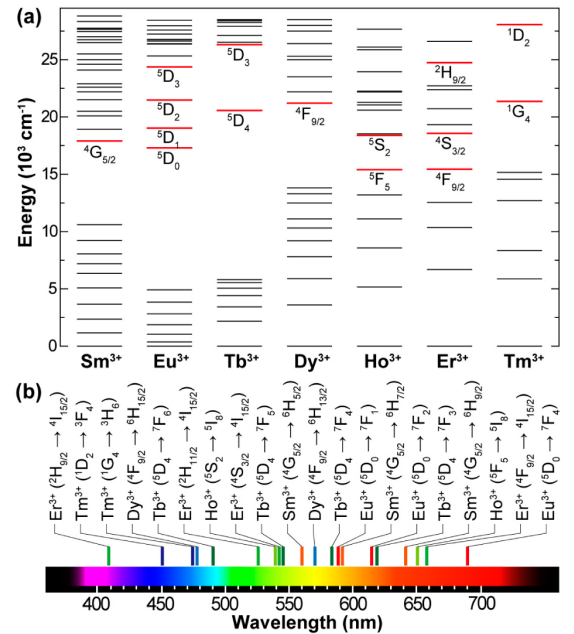
Typical Sensitizers Used in Nanoparticles for Transferring the Energy of Absorbed Light to Lanthanide Activators

Mediated energy migration through Gd sublattice
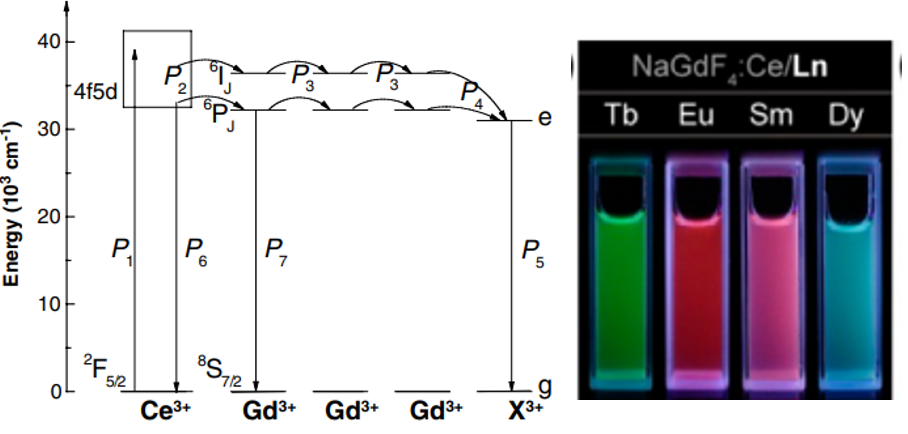
Typical energy transfer mechanisms used for emission tuning in lanthanide-doped materials.
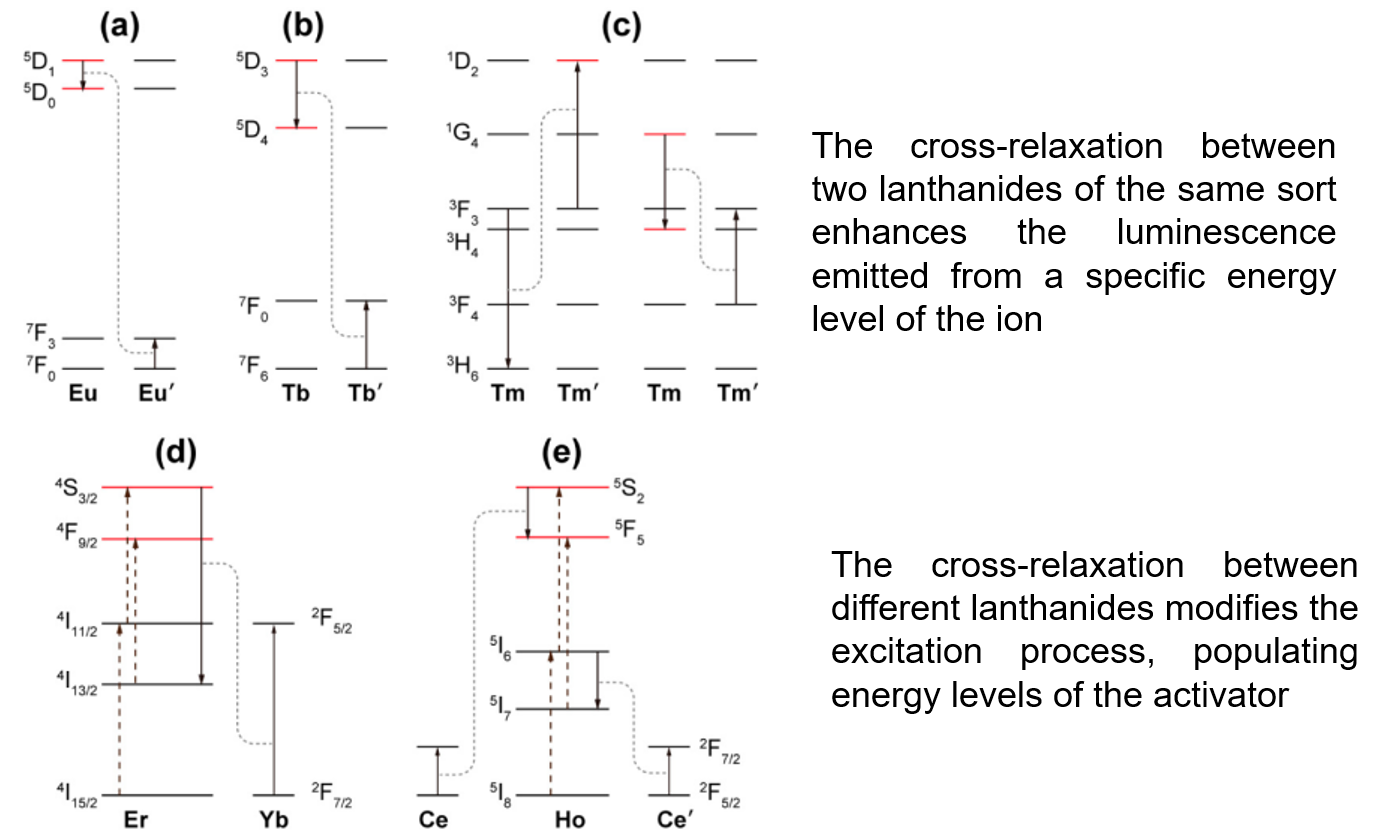 上图(d)其实是back-energy transfer from Er3+ to Yb3+,可以解释NaYF4:Yb/Er color tuning. 另外再共掺杂Tm3+也可以调颜色。
上图(d)其实是back-energy transfer from Er3+ to Yb3+,可以解释NaYF4:Yb/Er color tuning. 另外再共掺杂Tm3+也可以调颜色。
The versatility of the doping approach for fine-tuning emission colors was later confirmed by a number of research groups in a wide variety of host matrices incorporated with activator pairs of Er/Tm, Ho/Tm, and Eu/Tb.
存在的问题:It is worth noting that the activator concentrations should be kept substantially low (<2 mol %) to minimize activator−activator interactions.
不同NaYF4相中Er3+的发光不同:一个发光在660 nm最强,另一个相540 nm最强。It is believed that the phase-dependent emission is attributed to the varied site symmetry of lanthanide dopants in different host lattices.
BaTiO3:Yb/Er structural symmetry modified by applying a direct current bias voltage:
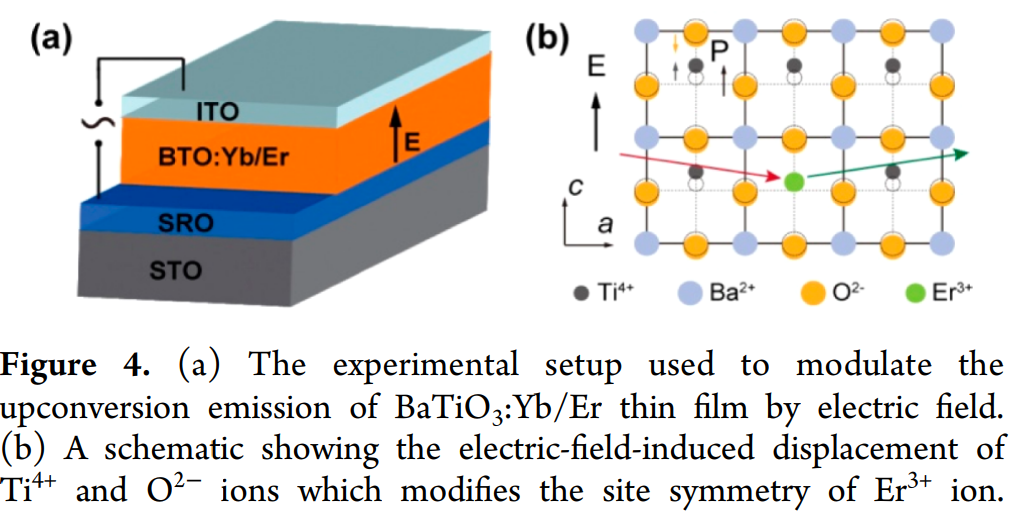
The emission spectrum of Er3+ dopant was dynamically modulated under a sinusoidal alternating current bias, opening up new avenues for potential applications such as electrically controlled upconvertors. On another matter, this approach may enable better understanding of the crystal-field effect on lanthanide luminescence because the site symmetry of the dopants can be systematically modulated in a single host material without the need for chemical composition modification.
The Effect of Particle Size:
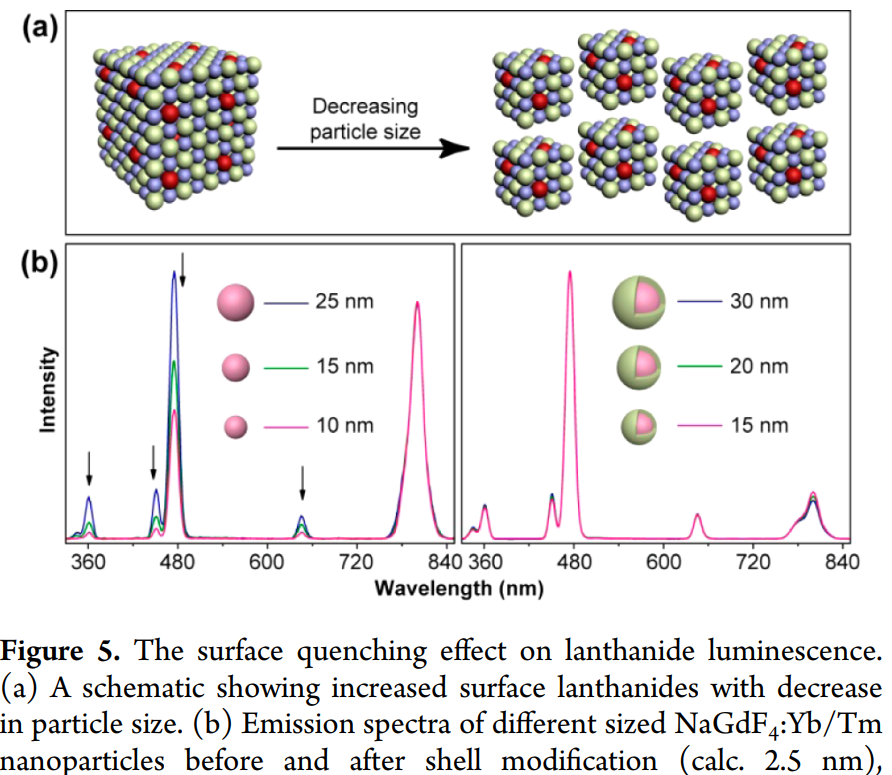
size dependent optical property is most likely attributed to a surface quenching effect rather than the quantum confinement effect, a phenomenon typically observed in quantum dots. As the particle size decreases, the concentration of the surface dopants steadily increases (Figure 5a), leading to the variation in the overall emission spectrum. 另外,尺寸小了会有更严重的surface quenching effect,可以通过thin surface protection layer来解决。
Host−Dopant Energy Transfer: For example, Mn2+ ions in MnF2:Yb/Er and KMnF3:Yb/Er nanoparticles can strongly interact with Er3+ ions to take away the excitation energy of Er3+ in the 4S3/2 state. Subsequent energy transfer from Mn2+ to Er3+ increases the population of Er3+ in its 4F9/2 state, resulting in an enlarged intensity ratio of red-to-green emission.
注:伍博士也做了类似的工作,发现It is found that the higher Mn2+ energy level position will facilitate the output of green UC emission from Er3+.[JMCC-2016]
Nanoscale core-shell相对bulk materials的优点:对前者来说the extensive dopant−dopant interactions in the host lattice may induce luminescence quenching. 但是,对后者来说nanoscale manipulation of lanthanide-doped nanoparticles permits spatial confinement of dopants within a nanoscopic region. Significantly, this effect allows integration of otherwise optically incompatible dopants into a single nanoparticle with welldefined energy exchange interactions, thereby opening up new opportunities for multicolor tuning.
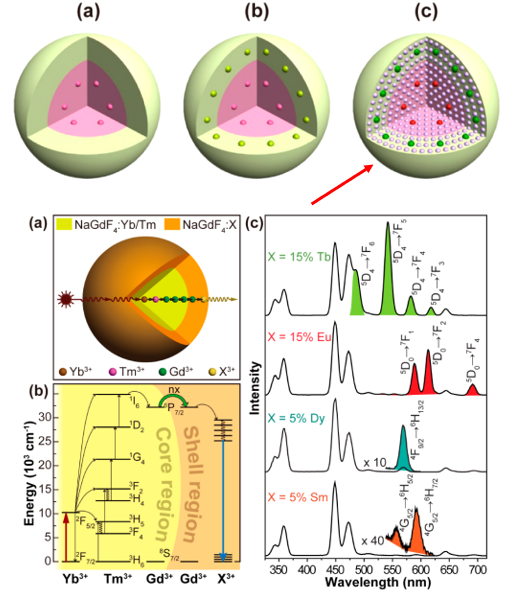
General core−shell strategies for spatial confinement of lanthanide dopants:
(a) The passive-shell coating design with the dopants merely incorporated in the core layer.
(b) The active-shell coating design with different types of lanthanides separately doped in the core and shell layers.
(c) The energy migration core−shell design featuring an optically active sublattice. 上图中Gd sublattice can initiate an energy migration process to bridge energy transfer through the core− shell interface (Figure 7b). This effect enables fine-tuning of upconversion emission for a wide range of lanthanide activators without long-lived intermediary energy states (Figure 7c), which are generally regarded as a prerequisite for photon upconversion.
Bulk materials 的energy migration存在的问题:Although the concept of energy migration has been well documented in the past, previous studies typically involve the use of energy migration in bulk materials that generally feature a homogeneous mixing of the lanthanide dopants with the migrator ions in the host lattice. In these bulk systems, the energy exchange interactions between the lanthanides are complex and uncontrollable, thereby limiting effective utilization of the energy migration process.
Assembly of Particle Building Blocks: The assembly of optical nanoparticles of different chemical properties into one composite particle may lead to potentially synergistic optical properties as a result of controlled interplay between the constituent entities. This approach adds an additional dimension to multicolor tuning.
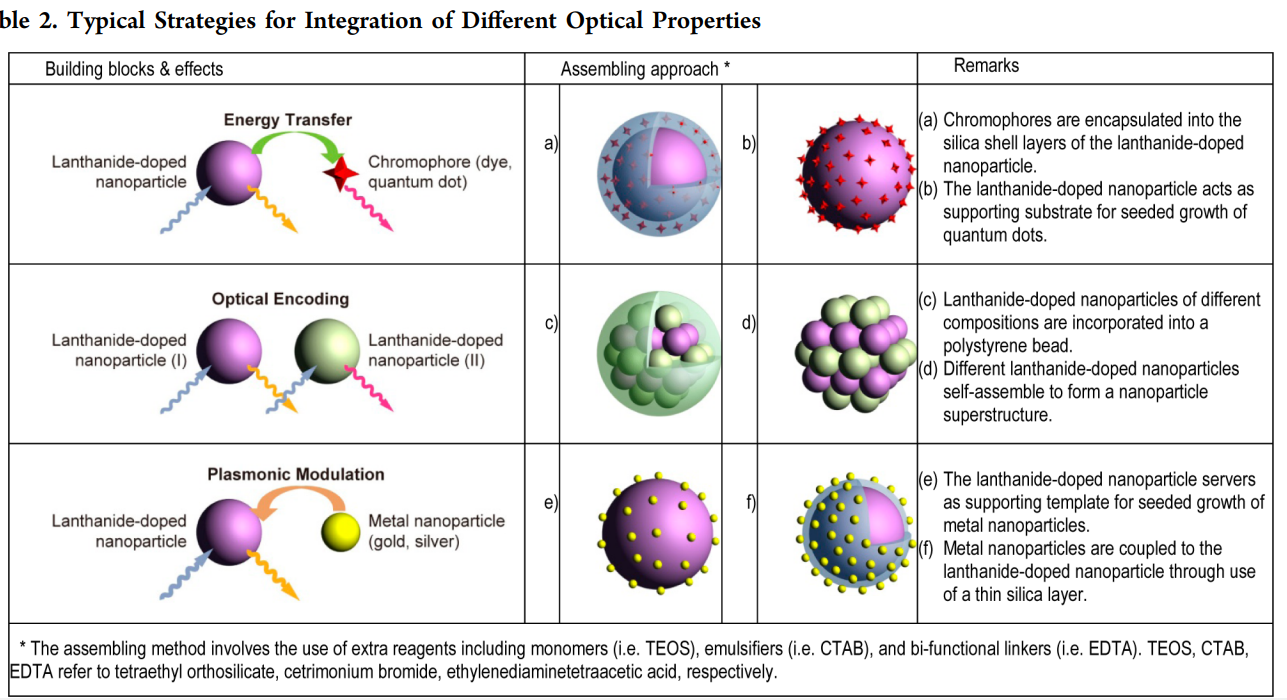
(a) In their work, NaYF4:Yb/Er nanoparticles served as platform for the growth of a mesoporous silica shell impregnated with either organic dyes or quantum dots. Upon excitation at 980 nm, the lanthanide activators give rise to upconverted emission that can be partially transferred to the guest optical entities encapsulated in the silica shell through Förster resonance energy transfer (FRET). Consequently, a dual emission with controllable intensity balance is achieved.
(b) CdSe-NaYF4:Yb/Er heterostructures that offer both sub-bandgap photoconductivity and tunable photoluminescence.
注:the emission of dye molecules and quantum dots can be completely attenuated owing to their substantially shorter lifetime (on the order of nanoseconds) than that of lanthanide ions (up to several milliseconds). 另外关于能量传递的机理,有人认为radiative reabsorption (second excitation) might also contribute to the energy transfer from the lanthanide ions to the dye molecules (or quantum dots) although it is generally believed that FRET mediates the optical interaction. (悬而未决)
(c) Lanthanide-doped nanoparticles for multicolor encoding: NaYF4:Yb/Er and NaYF4:Yb/Tm nanoparticles (∼25nm) encapsulated in polystyrene beads 聚苯乙烯微球 (Table 2c). By changing the molar ratio between the particles, the emission colors were deliberately tuned from green to blue.
(e) Metal nanoparticles in these nanocomposites typically do not emit light. Instead, they provide surface plasmons that could modify the local electromagnetic environment of lanthanide ions, potentially leading to the enhancement in luminescence emission of the lanthanides.
(f) Coating of silica-modified NaYF4:Yb/Er nanoparticles with gold nanoparticles (Table 2f). The authors found that the presence of gold nanoparticles strongly suppressed the emission of Er3+ at 540 nm.
荧光制冷效应
量子计算/通信
- 刘书萍-南方科技大学
- Nature | 量子通信:分子、稀土和光
- Quantum computing in Rare‐earth‐ion systems-Andreas Walther-Lund University